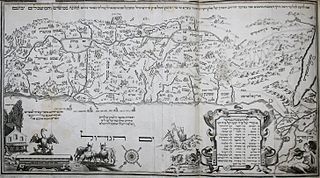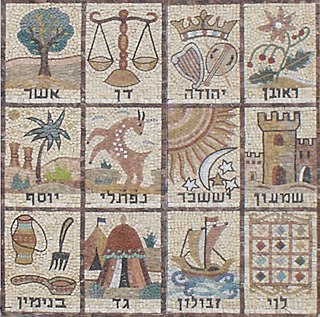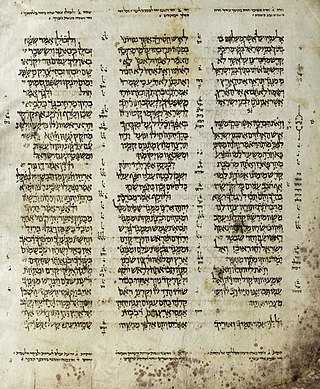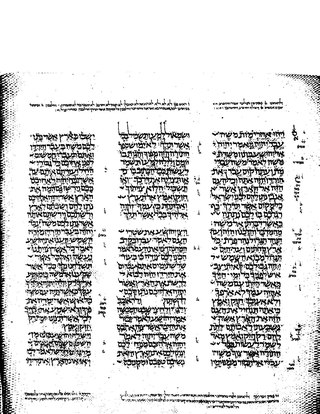
The Book of Judges is the seventh book of the Hebrew Bible and the Christian Old Testament. In the narrative of the Hebrew Bible, it covers the time between the conquest described in the Book of Joshua and the establishment of a kingdom in the Books of Samuel, during which Biblical judges served as temporary leaders.

Joshua, also known as Yehoshua, Jehoshua, or Josue, functioned as Moses' assistant in the books of Exodus and Numbers, and later succeeded Moses as leader of the Israelite tribes in the Book of Joshua of the Hebrew Bible. His name was Hoshea the son of Nun, of the tribe of Ephraim, but Moses called him "Yehoshua", the name by which he is commonly known in English. According to the Bible, he was born in Egypt prior to the Exodus.

According to the Hebrew Bible, the Tribe of Ephraim was one of the tribes of Israel. The Tribe of Manasseh together with Ephraim formed the House of Joseph. It is one of the ten lost tribes. The etymology of the name is disputed.

According to the Hebrew Bible, the Tribe of Manasseh was one of the twelve tribes of Israel. After the catastrophic Assyrian invasion of 720 BCE, it is counted as one of the ten lost tribes. Together with the Tribe of Ephraim, Manasseh also formed the House of Joseph.

Kinneret is the name of an important Bronze and Iron Age city situated on the northwestern shore of the Sea of Galilee, mentioned in the 14th century BC Aqhat Epic of Ugarit, and in the Old Testament and New Testament. Older Bible translations spell the name alternatively Kinnereth or Chinnereth, and sometimes in the plural as Chinneroth. In time the name became Gennesaret and Ginosar. The remains of Kinneret have been excavated at a site called Tell el-'Oreimeh in Arabic and Tel Kinrot in Modern Hebrew.
Aroer is the name of two biblical cities in the Transjordan, in what is today the Kingdom of Jordan.

The Twelve Tribes of Israel are, according to Hebrew scriptures, the descendants of the biblical patriarch Jacob, who collectively form the Israelite nation. The tribes were through his twelve sons through his wives, Leah and Rachel, and his concubines, Bilhah and Zilpah. In modern scholarship, there is skepticism as to whether there ever were twelve Israelite tribes, with the use of the number 12 thought more likely to signify a symbolic tradition as part of a national founding myth, although some scholars disagree with this view.
Anak is a figure in the Hebrew Bible. His descendants are mentioned in narratives concerning the conquest of Canaan by the Israelites. According to the Book of Numbers, Anak was a forefather of the Anakim, a Rephaite tribe according to Deuteronomy 2:11. In their report, ten of the twelve Israelite spies associated the Anakim with the Nephilim of Genesis 6:1–4.
Bamoth-Baal was an elevated point in the land of Moab mentioned in the Hebrew Bible. It was allotted to the Tribe of Reuben, and included with a list of towns near Heshbon. It is probably identical with the Bamoth between Nahaliel and the "valley that is in the country of Moab, to the top of Pisgah", mentioned in the list of stopping-places in Numbers 21:19-20. Bethbamot in the Moabite Stone, line 27, may also be considered as connected with it.

Abila was an ancient city east of the Jordan River in the Plains of Moab, later Peraea, near Livias, about twelve km northeast of the north shore of the Dead Sea. The site is identified with modern Khirbet el-Kafrayn, Jordan and identified on the Madaba Map as an unnamed icon. There is a widely supported theory that in the Hebrew Bible, it is referred to as Abel-Shittim, as well as in the shorter forms Shittim and Ha-Shittim.

V'Zot HaBerachah, VeZos HaBerachah, VeZot Haberakha, V'Zeis Habrocho, V'Zaus Haberocho, V'Zois Haberuchu, Wazoth Habborocho, or Zos Habrocho is the 54th and final weekly Torah portion in the annual Jewish cycle of Torah reading and the 11th and last in the Book of Deuteronomy. It constitutes Deuteronomy 33:1–34:12. The parashah sets out the farewell Blessing of Moses for the 12 Tribes of Israel and concludes with the death of Moses.
Kanah is a toponym used in two distinct geographical contexts in the Hebrew Bible.
Karkaa was a city or place mentioned in the Bible near Adar and Azmon, about midway between the Mediterranean Sea and the Dead Sea. The place is mentioned only once as one of the landmarks on the south boundary of the tribe of Judah and its present location is unknown.(Joshua 15:3).

Transjordan, also known as the East Bank or the Transjordanian Highlands, is the part of the Southern Levant east of the Jordan River, mostly contained in present-day Jordan.

Joshua 13 is the thirteenth chapter of the Book of Joshua in the Hebrew Bible or in the Old Testament of the Christian Bible. According to Jewish tradition the book was attributed to Joshua, with additions by the high priests Eleazar and Phinehas, but modern scholars view it as part of the Deuteronomistic History, which spans the books of Deuteronomy to 2 Kings, attributed to nationalistic and devotedly Yahwistic writers during the time of the reformer Judean king Josiah in 7th century BCE. This chapter records the list of land still to be conquered and the land allotments for the tribes Reuben, Gad and half of the Manasseh (east), a part of a section comprising Joshua 13:1–21:45 about the Israelites allotting the land of Canaan.

According to the Hebrew Bible, the Tribe of Reuben was one of the twelve tribes of Israel. Unlike the majority of the tribes, the land of Reuben, along with that of Gad and half of Manasseh, was on the eastern side of the Jordan and shared a border with Moab. According to the biblical narrative, the Tribe of Reuben descended from Reuben, the eldest son of the patriarch Jacob. Reuben, along with nine other tribes, is reckoned by the Bible as part of the northern kingdom of Israel, and disappears from history with the demise of that kingdom in c. 723 BC.

According to the Hebrew Bible, the Tribe of Zebulun was one of the twelve tribes of Israel. Following the completion of the conquest of Canaan by the Israelite tribes in the Book of Joshua, Joshua allocated the land among the twelve tribes. The territory Zebulun was allocated was at the southern end of the Galilee, with its eastern border being the Sea of Galilee, the western border being the Mediterranean Sea, the south being bordered by the Tribe of Issachar, and the north by Asher on the western side and Naphtali on the eastern.

According to the Bible, the Tribe of Gad was one of the Twelve Tribes of Israel who, after the Exodus from Egypt, settled on the eastern side of the Jordan River. It is one of the ten lost tribes.

According to the Hebrew Bible, the Tribe of Asher was one of the Tribes of Israel descended from Asher, the eighth son of Jacob. It is one of the ten lost tribes.
![]() This article incorporates text from a publication now in the public domain : Easton, Matthew George (1897). "Zareth-shahar". Easton's Bible Dictionary (New and revised ed.). T. Nelson and Sons.
This article incorporates text from a publication now in the public domain : Easton, Matthew George (1897). "Zareth-shahar". Easton's Bible Dictionary (New and revised ed.). T. Nelson and Sons.








